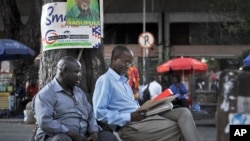Tanzania aims to better protect its city dwellers from floods and other climate-related threats through an urban resilience program launched this week.
The initiative comes as the country is grappling with the worsening impacts of climate change, such as frequent flooding and recurring drought.
More than half the world’s population now lives in cities, and the United Nations projects that share will rise to 66 percent by 2050, with close to 90 percent of the increase taking place in urban areas of Africa and Asia.
While this growth will globally create wealth and reduce poverty, analysts say many cities are increasingly vulnerable to flooding, putting lives and property at risk.
Threatened by flooding
In East Africa, Tanzania is bearing the heaviest burden of flooding, which threatens infrastructure assets worth $5.3 billion in Dar es Salaam, the World Bank said at the launch of Tanzania’s urban program Wednesday.
Home to more than 4.5 million people, the nation’s commercial capital is vulnerable to flooding, which cripples the ability of poorer city residents to access clean water and better sanitation, officials said.
The new initiative, a collaboration between Britain’s Department for International Development, the World Bank and the Tanzanian government, aims to find ways to cushion people from weather-related disasters, such as identifying flood-prone areas and drawing up preparedness plans.
Moses Msuya, director of the disaster management department in the Prime Minister’s Office, said the program includes strategic actions, such as installing early warning systems, to boost Tanzania’s ability to respond to disasters and help people recover rapidly.
“Let us make good use of every opportunity to make our cities more resilient for people now and for our children’s future,” he said.
According to Msuya, many Tanzanian cities are at risk of flooding because of poor infrastructure, including a lack of storm drainage canals.
“Rapid urbanization is increasing our vulnerability to climate-related risks. Our cities have undergone massive spatial expansion with the majority of residents living in unplanned settlements,” he said.
According to the World Bank, the program will use scientific methods to evaluate risks, and install early warning and monitoring equipment to prepare vulnerable communities for emergencies.
“No disaster is entirely natural,” said Edward Anderson, a disaster risk management specialist with the World Bank. “Disaster itself is often a failure in development planning.”
Teaching resilience
As part of its strategy, the government will develop a “Resilience Academy,” in which the concept of resilience will be taught at university level to help younger generations tackle natural disasters and other threats, officials said.
Osiligi Lossai, local ward official for the Tandale neighborhood of Dar es Salaam, said flood risks are more severe in crowded slum areas like his.
“My people have suffered a lot, and they keep incurring huge losses every single year,” he said.
According to a recent World Bank report on greening Africa’s cities, protecting fast-degrading environments in growing cities like Dar es Salaam can make them more liveable, and help them cope with extreme weather.
“Restoring forest areas and rehabilitating river systems could alleviate urban flooding problems, and make cities more pleasant and productive places to live,” Bella Bird, the World Bank’s country director for Tanzania, told the urban program launch.









